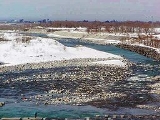
Kurobe River
Encyclopedia
The is a river in Toyama Prefecture
, Japan
. 86 km in length, it has a watershed of 689 km².
The river rises from Mount Washiba in the Hida Mountains
and carves the deep valley known as the Kurobe gorge. It comes out of the mountains at Unazuki
and forms an alluvial fan
which directly sinks into the Sea of Japan
.
The Kurobe River's rich flow and steep gradient offer good conditions for hydroelectricity
. The Kurobe Dam
is the tallest dam
in Japan.
The name Kurobe is meaningless in Japanese. It appears to be an Ainu
name, kur pet [kuɾᵘbet] 'shady river'.
Toyama Prefecture
is a prefecture of Japan located in the Hokuriku region on Honshū island. The capital is the city of Toyama.Toyama is the leading industrial prefecture on the Japan Sea coast, and has the industrial advantage of cheap electricity due to abundant water resources....
, Japan
Japan
Japan is an island nation in East Asia. Located in the Pacific Ocean, it lies to the east of the Sea of Japan, China, North Korea, South Korea and Russia, stretching from the Sea of Okhotsk in the north to the East China Sea and Taiwan in the south...
. 86 km in length, it has a watershed of 689 km².
The river rises from Mount Washiba in the Hida Mountains
Hida Mountains
The , or , is a Japanese mountain range which stretches through Nagano, Toyama and Gifu prefectures. A small portion of the mountains also reach into Niigata Prefecture. William Gowland coined the phrase "Japanese Alps" during his time in Japan, but he was only referring to the Hida Mountains when...
and carves the deep valley known as the Kurobe gorge. It comes out of the mountains at Unazuki
Unazuki, Toyama
was a town located in Shimoniikawa District, Toyama, Japan.On March 31, 2006 Unazaki was merged into the city of Kurobe.As of 2003, the town had an estimated population of 6,178 and a density of 18.19 persons per km². The total area was 339.58 km²....
and forms an alluvial fan
Alluvial fan
An alluvial fan is a fan-shaped deposit formed where a fast flowing stream flattens, slows, and spreads typically at the exit of a canyon onto a flatter plain. A convergence of neighboring alluvial fans into a single apron of deposits against a slope is called a bajada, or compound alluvial...
which directly sinks into the Sea of Japan
Sea of Japan
The Sea of Japan is a marginal sea of the western Pacific Ocean, between the Asian mainland, the Japanese archipelago and Sakhalin. It is bordered by Japan, North Korea, Russia and South Korea. Like the Mediterranean Sea, it has almost no tides due to its nearly complete enclosure from the Pacific...
.
The Kurobe River's rich flow and steep gradient offer good conditions for hydroelectricity
Hydroelectricity
Hydroelectricity is the term referring to electricity generated by hydropower; the production of electrical power through the use of the gravitational force of falling or flowing water. It is the most widely used form of renewable energy...
. The Kurobe Dam
Kurobe dam
The or , is a variable-radius arch dam on the Kurobe River in Toyama Prefecture on the island of Honshū, Japan. It supports the 335 MW Kurobe No. 4 Hydropower Plant and is owned by Kansai Electric Power Company. At high, it is the tallest dam in Japan. It was constructed between 1956 and 1963 at...
is the tallest dam
Dam
A dam is a barrier that impounds water or underground streams. Dams generally serve the primary purpose of retaining water, while other structures such as floodgates or levees are used to manage or prevent water flow into specific land regions. Hydropower and pumped-storage hydroelectricity are...
in Japan.
The name Kurobe is meaningless in Japanese. It appears to be an Ainu
Ainu languages
The Ainu languages were a small language family spoken on the northern Japanese island of Hokkaidō, the southern half of the island of Sakhalin, and the Kuril Islands, an island chain that stretches from Hokkaidō to the southern tip of the Kamchatka Peninsula. They are alternately considered a...
name, kur pet [kuɾᵘbet] 'shady river'.

